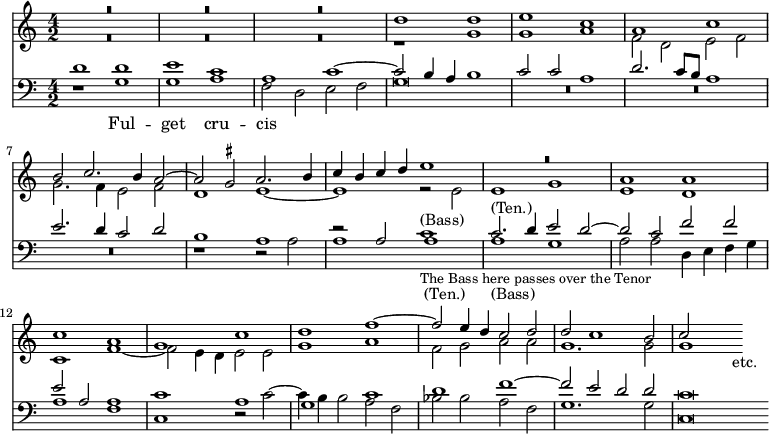
A few Latin Hymns, such as those to be found among the works of Hassler, Tallis, Byrd, and some other great composers, have been set, for 4 or more voices, in a similar manner: but, as a whole, Palestrina's magnificent Hymnal stands quite alone—too great to admit the possibility of rivalry. The delight with which it was received was unbounded. Indeed, long before the middle of the 16th century, the Science of Hymnology had already begun to attract an immense amount of attention, in widely different directions. Hymns, or rather [1]Carols, of a somewhat lighter character than those we have been considering, had been sung, for ages past, between the scenes of the Mysteries and Miracle Plays which form so conspicuous a feature in the religious history of the middle ages. Many of these—notably such as set forth the Glad Tidings commemorated at Christmas-tide—became, from time to time, extremely popular, and obtained a firm hold on the affections of rich and poor alike. [See Noël.] Well knowing the effect of songs upon popular feeling, and fully appreciating the beauty of the Latin hymns to which he had been accustomed from his earliest youth, Luther turned these circumstances to account by producing a vast amount of German Kirchenlieder, which, adapted to the most favourite melodies of the day, both sacred and sæcular, and set for four, five, and six voices, (with the Plain Chaunt in the Tenor,) by Johannes Walther, were first published, at Wittenberg, in 1524, and re-issued, in the following year, with a special preface by Luther himself. Innumerable other works of a similar description followed in rapid succession. The vernacular Hymn found its way more readily than ever to the inmost heart of the German people. The Chorale was sung, far and wide; and, at last,
under the treatment of John Sebastian Bach, its beauties were developed, with a depth of insight into its melodic and harmonic resources which is not likely ever to be surpassed. Even the simplest settings of this great master bear tokens of a certain individuality which will render them household words, in the land of their birth, as long as true musical expression shall continue to be valued at its true worth: and, perhaps, in these gentle inspirations, Bach speaks more plainly to the outer world than in some cases where he has subjected the melody to more elaborate treatment. [See Chorale.]
Nun ruhen alle Wälder.

In France, the Metrical Psalms of Clement Marot, and Theodore Beza, were no less enthusiastically received than the Hymns of Luther in Germany, though their popularity was less lasting. They were originally sung to the most familiar ditties of the time, which were adapted to them, probably by Guillaume Franc, in the Psalter first published by Calvin at Geneva in 1543. In 1561, Louis Bourgeois published a volume, at Lyons, containing 83 of these Tunes, set for four, five, and six voices; and, in 1565, Adrian Le Roy printed, at Paris, an entire Psalter, in which the melodies were treated, after the manner of Motets, by Claude Goudimel. This last-named work was reprinted, in Holland, in 1607: but Goudimel's polyphonic settings were found too difficult for general use, and were supplanted, after a time, by some less elaborate arrangements—with the melody, as usual, in the Tenor—by Claudin le Jeune, whose collection was published at Leyden in 1633.
- ↑ Ital. Carola; from carolare, to sing songs of joy. Balley, however, suggests a Saxon etymon; ceorl, rustle—whence 'churl.'

